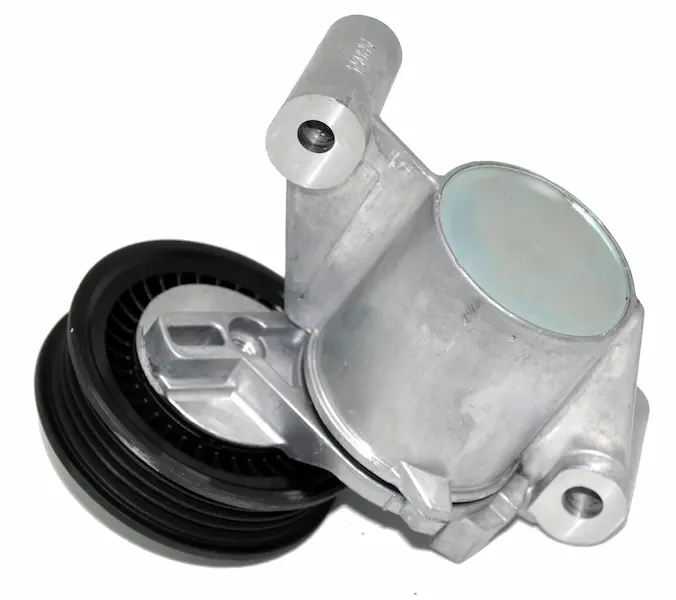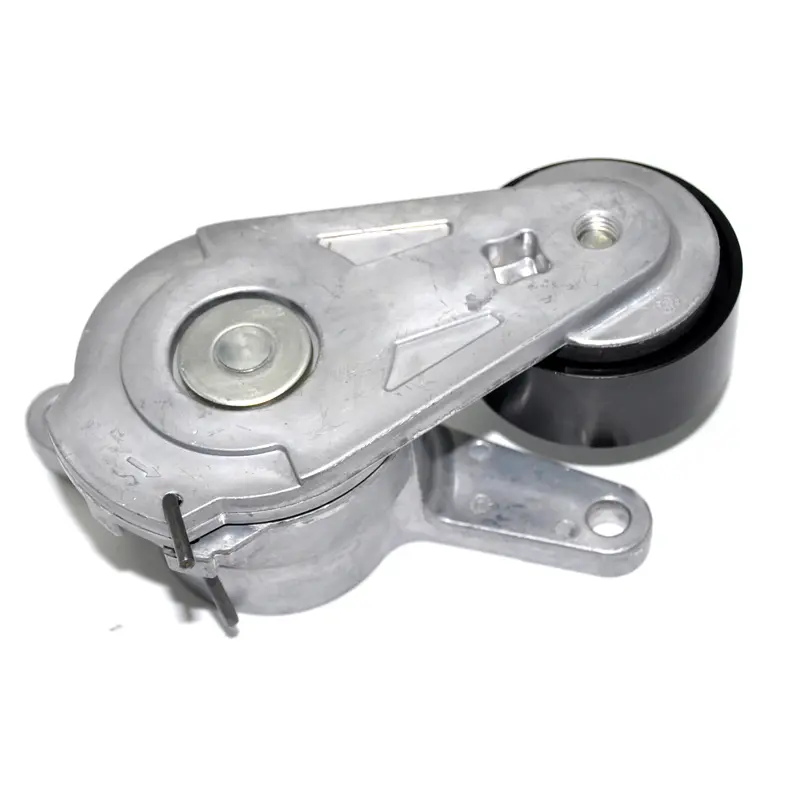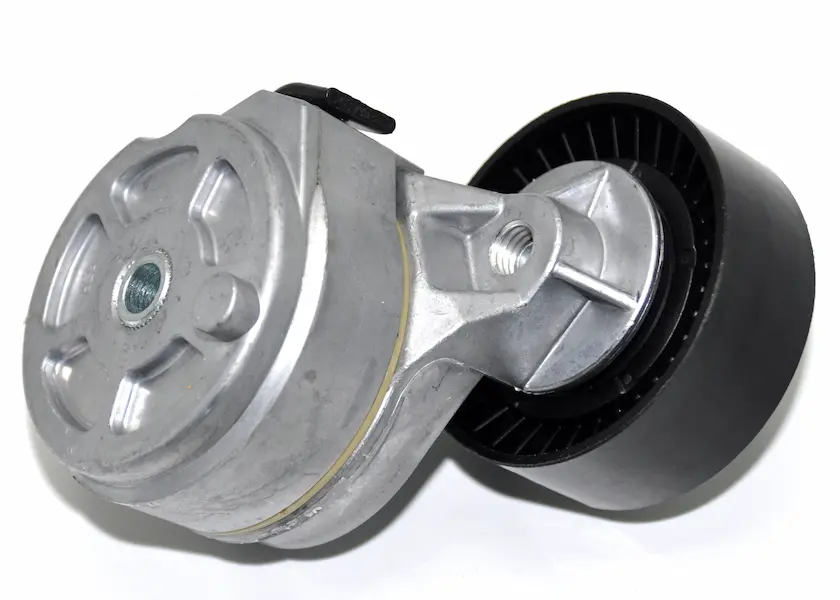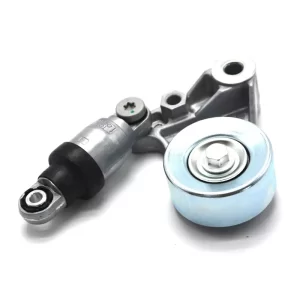Automobiļu un rūpniecisko iekārtu pasaulē siksnu piedziņas sistēmu efektivitāte un uzticamība ir ļoti svarīga iekārtu veiktspējai un ilgmūžībai. Bieži vien netiek ņemta vērā viena no sastāvdaļām, kurai šajās sistēmās ir izšķiroša nozīme. tukšgaitas skriemeļa siksnas spriegotājs. Neskatoties uz nelielo izmēru un šķietami vienkāršo funkciju, trīsuļa siksnas spriegotājam ir būtiska nozīme, lai nodrošinātu, ka siksnas ir pareizi nospriegotas, izlīdzinātas un neslīd. Šajā rakstā ir aplūkota trīšu siksnu spriegotāju nozīme siksnu slīdēšanas novēršanā, izpētīta to konstrukcija, funkcionalitāte un priekšrocības, ko tie sniedz mehānisko sistēmu vienmērīgas darbības nodrošināšanā.
Izpratne par jostu vadītām sistēmām
Pirms pievēršaties konkrētajai trīšu siksnu spriegotāju lentei, ir svarīgi izprast siksnu piedziņas sistēmu pamatus. Gan automobiļu dzinējos, gan rūpnieciskajās iekārtās siksnas piedziņas sistēmas parasti tiek izmantotas, lai pārsūtītu jaudu no vienas sastāvdaļas uz citu. Piemēram, iekšdedzes dzinējā serpentīna siksna tiek izmantota, lai darbinātu vairākus piederumus, piemēram, alternatoru, stūres pastiprinātāja sūkni, ūdens sūkni un gaisa kondicionēšanas kompresoru.
Siksna darbojas, aptinoties ap rullīšiem, kas piestiprināti rotējošiem komponentiem, un nodod motora mehānisko jaudu šiem piederumiem. Lai siksna darbotos efektīvi, tai jāuztur noteikts spriegojums, lai novērstu slīdēšanu, kas var izraisīt efektivitātes samazināšanos, komponentu bojājumus vai pat sistēmas atteici.
Siksnas spriegotāju funkcija
Tītara trīšu siksnas spriegotāji ir paredzēti, lai uzturētu pareizu siksnas spriegojumu un nodrošinātu tās izlīdzināšanu sistēmas kustības laikā. Šie spriegotāji sastāv no atsperes piestiprinātas sviras, kas savienota ar trīsi, kura piespiež siksnu, lai uzturētu tās spriegojumu. Atsperes mehānisms kompensē jebkādas siksnas spriegojuma svārstības, ko izraisa termiskā izplešanās, nodilums vai citi faktori.
Spriegotāja galvenā funkcija ir novērst siksnas slīdēšanu, kas ir bieži sastopama problēma siksnas piedziņas sistēmās un var radīt nopietnas sekas. Slīdēšana rodas, kad siksna zaudē saķeri ar trīšiem, un tā slīd pa virsmu, nevis efektīvi virza trīšus. Tas var izraisīt jaudas pārneses zudumu, samazināt efektivitāti un palielināt gan siksnas, gan skriemeļu nodilumu. Smagos gadījumos siksnas slīdēšana var izraisīt pilnīgu siksnas atdalīšanos no trīšiem, izraisot sistēmas atteici un iespējamus citu sastāvdaļu bojājumus.
Kā siksnas spriegotāji novērš siksnas slīdēšanu
Siksnas spriegotāji novērš siksnas slīdēšanu, izmantojot vairākus galvenos mehānismus:
1. Pareiza siksnas spriegojuma uzturēšana
Svarīgākais trīšu siksnas spriegotāja uzdevums ir pastāvīgi uzturēt pareizu siksnas spriegojumu. Spriegotāja atsperu mehānisms automātiski pielāgojas siksnas garuma izmaiņām, ko izraisa nodilums, izstiepšanās vai termiskā izplešanās. Uzturot siksnu saspriegtu, spriegotājs nodrošina, ka siksna saglabā pietiekamu berzi ar skriemeļiem, lai efektīvi nodotu jaudu. Bez pietiekama spriegojuma siksna zaudētu saķeri, kas izraisītu slīdēšanu.
Pareizs siksnas spriegojums palīdz arī vienmērīgi sadalīt slodzi pa siksnu, tādējādi samazinot lokāla nodiluma vai bojājumu risku. Tas ne tikai novērš slīdēšanu, bet arī pagarina siksnas un skriemeļu kalpošanas laiku, samazinot nepieciešamību pēc biežas apkopes un nomaiņas.
2. Precīzas jostas izlīdzināšanas nodrošināšana
Bez spriegojuma uzturēšanas, trīšu siksnu spriegotājiem ir svarīga loma, lai nodrošinātu, ka siksna, pārvietojoties sistēmā, paliek pareizi izlīdzināta. Vēl viens biežs siksnas slīdēšanas iemesls ir nepareiza izlīdzināšana, jo tā var izraisīt siksnas novirzīšanos no centra, samazinot saskares laukumu ar trīšiem un palielinot slīdēšanas iespējamību.
Spriegotāja tukšgaitas skriemelis palīdz vadīt siksnu, noturot to pareizā pozīcijā, kad tā pārvietojas pa dažādiem sistēmas skriemeļiem. Nodrošinot precīzu izlīdzināšanu, spriegotājs samazina slīdēšanas risku un novērš nevienmērīgu siksnas un skriemeļu nodilumu.
3. Jostas nodiluma un izstiepšanās kompensēšana
Laika gaitā siksnas dabiski nodilst un izstiepjas, un tas var izraisīt spriegojuma zudumu. Ja nebūtu spriegotāja, šis spriegojuma zudums varētu izraisīt vieglāku siksnas slīdēšanu, kas samazinātu efektivitāti un potenciālu sistēmas kļūmi. Siksnas spriegotājs kompensē šo nodilumu un izstiepšanos, automātiski pielāgojot spriegojumu, lai uzturētu siksnas spriegojumu.
Šī automātiskā regulēšana ir īpaši svarīga sistēmās, kurās josta ir pakļauta mainīgai slodzei un temperatūrai, jo šie faktori var izraisīt jostas izplešanos vai saraušanos. Nepārtraukti uzturot pareizu spriegojumu, spriegotājs nodrošina, ka josta ir efektīva visā tās kalpošanas laikā, samazinot nepieciešamību pēc manuālas regulēšanas un apkopes.
4. Vibrāciju slāpēšana un trokšņa samazināšana
Vēl viens veids, kā trīsuļa siksnas spriegotāji novērš siksnas slīdēšanu, ir siksnas vibrāciju slāpēšana. Vibrācijas var izraisīt siksnas lēkšanu vai drebēšanu, kā rezultātā siksna ar pārrāvumiem zaudē kontaktu ar trīšiem un galu galā izslīd. Spriegotāja atsperes konstrukcija palīdz absorbēt šīs vibrācijas, saglabājot siksnas stabilitāti un nodrošinot nepārtrauktu saskaņu ar trīšiem.
Papildus slīdēšanas novēršanai, vibrāciju slāpēšana samazina arī troksni, kas bieži vien liecina par slikti nospriegotu vai nepareizi izlīdzinātu siksnu. Uzturot vienmērīgu un klusu darbību, spriegotājs veicina sistēmas vispārējo uzticamību un komfortu.
Drošības jostas noslīdēšanas sekas
Siksnas slīdēšana var šķist nenozīmīga problēma, taču tai var būt nopietnas sekas gan automobiļu, gan rūpniecības sistēmās. Dažas no iespējamām problēmām, ko rada siksnas slīdēšana, ir šādas:
1. Samazināta efektivitāte un veiktspēja
Ja siksna izslīd, tā zaudē spēju efektīvi pārnest jaudu no viena komponenta uz otru. Automobiļos tas var izraisīt kritiski svarīgu palīgierīču, piemēram, ģeneratora, stūres pastiprinātāja un gaisa kondicionēšanas sistēmas, darbības samazināšanos. Rūpniecības mašīnās siksnas slīdēšana var izraisīt produktivitātes un efektivitātes samazināšanos, jo mašīnas var nedarboties ar pilnu jaudu.
2. Paaugstināts nolietojums
Siksnas slīdēšana var palielināt gan siksnas, gan skriemeļu nodilumu. Siksnai slīdot, tā rada siltumu un berzi, kas var izraisīt paātrinātu nodilumu un iespējamus bojājumus. Laika gaitā šis nodilums var vājināt siksnu, padarot to jutīgāku pret pārrāvumiem. Līdzīgi var nolietoties vai tikt bojāti skriemeļi, kā rezultātā var rasties nepieciešamība pēc dārgas nomaiņas.
3. Sistēmas atteice un dīkstāve
Smagos gadījumos siksnas slīdēšana var izraisīt pilnīgu siksnas atdalīšanos no trīšiem, kas var izraisīt sistēmas atteici. Automobiļos tas var izraisīt jaudas zudumu svarīgākajiem komponentiem, un transportlīdzeklis var nonākt strupceļā. Rūpniecībā pārtrūkusi vai izplīsusi siksna var izraisīt iekārtu izslēgšanos, kas rada dārgas dīkstāves un produktivitātes zudumu.
4. Drošības riski
Dažos gadījumos jostas slīdēšana var apdraudēt drošību. Piemēram, automašīnām slīdoša siksna var izraisīt stūres pastiprinātāja vai ģeneratora darbības traucējumus, kas var ietekmēt vadītāja spēju vadīt transportlīdzekli. Rūpnieciskajās iekārtās plīstoša siksna var izjaukt kustīgo daļu līdzsvaru, palielinot operatoru traumu vai iekārtas bojājumu risku.
Augstas kvalitātes siksnas spriegotāja priekšrocības, izmantojot augstas kvalitātes siksnas spriegotāju
Ņemot vērā trīšu siksnu spriegotāju kritisko nozīmi siksnas slīdēšanas novēršanā, ir svarīgi izmantot augstas kvalitātes spriegotāju, kas ir izstrādāts atbilstoši jūsu konkrētā lietojuma prasībām. Dažas no priekšrocībām, ko sniedz augstas kvalitātes trīšu siksnas spriegotāja izmantošana, ir šādas:
1. Lielāka uzticamība
Augstas kvalitātes spriegotājs ir izgatavots tā, lai kalpotu ilgi, un pastāv mazāka iespējamība, ka tas sabojās nepārtrauktas ekspluatācijas slodzes apstākļos. Uzturot pareizu spriegojumu un izlīdzināšanu, uzticams spriegotājs nodrošina, ka jūsu siksnas piedziņas sistēma darbojas vienmērīgi un efektīvi, samazinot slīdēšanas un sistēmas kļūmes risku.
2. Pagarināts siksnas un skriemeļu kalpošanas laiks
Augstas kvalitātes spriegotājs, novēršot slīdēšanu un samazinot nodilumu, var pagarināt gan siksnas, gan skriemeļu kalpošanas laiku. Tādējādi samazinās nepieciešamība pēc biežas nomaiņas un tehniskās apkopes, ilgtermiņā ietaupot jūsu laiku un naudu.
3. Uzlabota veiktspēja
Optimālai sistēmas darbībai ir svarīga pareizi nospriegota un izlīdzināta siksna. Neatkarīgi no tā, vai braucat ar transportlīdzekli vai ekspluatējat rūpnieciskās iekārtas, augstas kvalitātes spriegotājs palīdz nodrošināt, ka jūsu iekārtas darbojas maksimāli efektīvi, maksimāli palielinot produktivitāti un samazinot dīkstāves laiku.
4. Pastiprināta drošība
Uzticams spriegotājs var palīdzēt novērst problēmas, kas var izraisīt nelaimes gadījumus vai traumas, piemēram, automobiļu sistēmās, kur drošība ir svarīgs jautājums, piemēram, automobiļu sistēmās. Uzturot kritisko komponentu pareizu darbību, augstas kvalitātes spriegotājs veicina sistēmas vispārējo drošību un uzticamību.
Secinājums
Noslēgumā jāsecina, ka siksnu spriegotājiem ir būtiska nozīme siksnas slīdēšanas novēršanā un siksnas piedziņas sistēmu raitas darbības nodrošināšanā. Uzturot pareizu siksnas spriegojumu, nodrošinot precīzu izlīdzināšanu, kompensējot nodilumu un izstiepšanos, kā arī slāpējot vibrācijas, šie spriegotāji palīdz nodrošināt efektīvu un uzticamu sistēmu darbību. Jostas slīdēšanas sekas var būt nopietnas, jo tās var izraisīt efektivitātes samazināšanos, paaugstinātu nodilumu, sistēmas atteici un drošības riskus. Tāpēc ieguldījums augstas kvalitātes trīšu siksnu spriegotājā ir būtisks ikvienam, kas vēlas optimizēt savu iekārtu veiktspēju un ilgmūžību.
Neatkarīgi no tā, vai veicat automobiļa dzinēja apkopi vai ekspluatējat rūpniecības iekārtas, uzticama spriegotāja lietošanas priekšrocības ir acīmredzamas. Novēršot siksnas slīdēšanu, augstas kvalitātes spriegotājs palīdz nodrošināt, ka jūsu ar siksnu darbināmās sistēmas darbojas vienmērīgi, efektīvi un droši, samazinot dārgu dīkstāves un remonta risku.




